By Robert Bruce
“Training missions from Maritime Homeland Security and Defense to expeditionary warfare, SMTC has the ability to standardize tactics, techniques and procedures which equates to effective operations in the joint maritime environment.” Captain E. L. Alexander, Commanding Officer, USCG Special Missions Training Center
Dramatic video segments showing machine gun toting patrol boats roaring along waterways and ocean intercepts of drug smuggling “go-fast” boats are familiar to those of us who pay attention to news about military units involved in anti-terror and security activities at home and abroad.
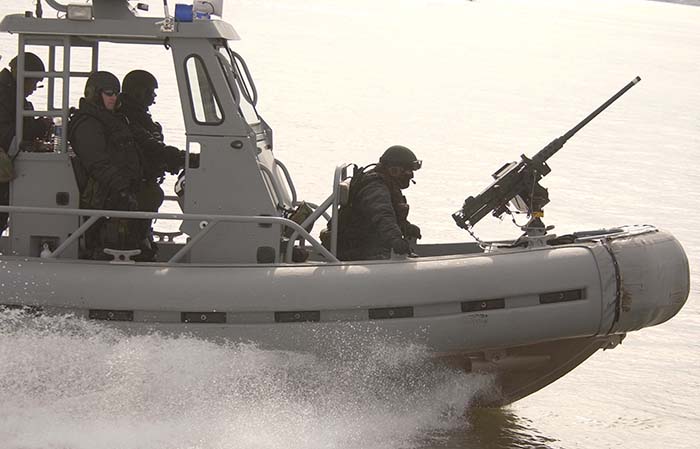
(US Navy photo by PHM2 Robert Schalk)
Dedicated and hard working members of the Navy, Coast Guard and Marine Corps are out there every day of the year, around the clock, in all kinds of weather, all over the globe. They protect harbor facilities, escort high value assets like aircraft carriers, run waterborne patrols and raids along Iraq’s rivers, board and search commercial shipping, find and stop narcotics traffickers.
But few pause to wonder how the skilled sailors and others who perform these missions receive their specialized training. Where do coxswains go to learn to maneuver small, swift patrol craft and keep them from foundering in heavy seas? Who teaches all those gunners to hang on to free-swinging, boat mounted machine guns while bringing effective and accurate fire on a fast moving target across roller coaster waves? Where does one go to quickly learn from experts with years of real-world experience in maritime military operations?
The US Coast Guard’s Special Missions Training Center (SMTC) is a one-stop resource for a host of critical components in the Global War on Terror (GWOT). Ideally located since 1998 as a major tenant activity aboard the sprawling US Marine Corps Base, Camp Lejeune, on the Atlantic Ocean coastline of North Carolina, this little known but enormously valuable operation trains personnel and elite formations of three branches of the US Armed Forces. Moreover, its Testing and Evaluation branch conducts operational tests of new weapons and equipment – including non-lethal technologies – and its Doctrine branch standardizes GWOT tactics, techniques and procedures.
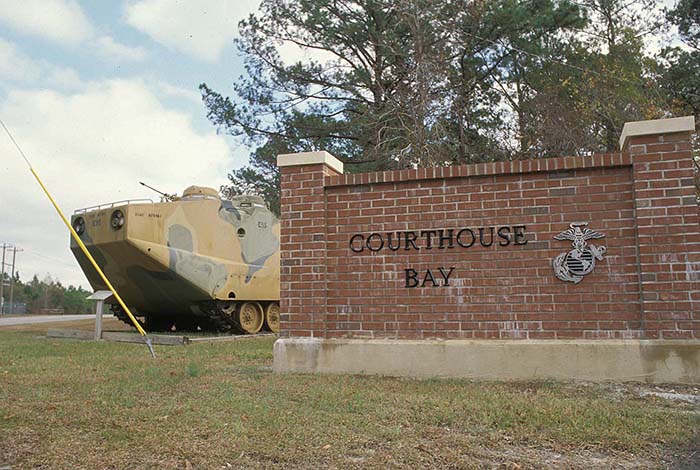
In addition to full spectrum training for the Coast Guard’s own Port Security Units, Maritime Safety and Security Teams, and Cutter Boat counter drug operators; SMTC trains Marine Corps small boat operators in Dam Security Units, as well as the Navy’s Inshore Boat Units and Mobile Security Force.
The center’s “can-do” curriculum includes everything from entry level field training to deep sea small boat operations. In between we find basic and advanced certification for coxswains, those “boat drivers” who skipper the small, fast but vulnerable tactical watercraft, as well as instruction in weapons and tactics from non-lethal devices to 40mm high explosive grenade machine guns.
Crew Served Weapons Course
It is, of course, the weapons set that is of greatest interest to SAR’s readers so we briefly joined a class in progress as a group of mostly Navy Mobile Security sailors were going through the Small Boat Crew Served Weapons Operations and Maintenance Course. This 13 day entry level program focuses on three of the most effective machine guns in the US Armed Forces; the 7.62mm M240, .50 caliber M2HB and the 40mm Mark 19. Along the way they would learn about and demonstrate mastery of a long list of the expected critical tasks; like operation, maintenance and tactical applications, as well as land and waterborne live fire by day and night.
Additionally, significant emphasis is given to other topics to minimize innocent civilian casualties as well as those among US forces inflicted by predatory lawyers and hostile news organizations. Let there be no doubt about the wisdom and necessity for thoroughly ingraining in these gunners the principles of restrained escalation of force, legal aspects in Status of Forces Agreements, and Rules of Engagement.
Our first encounter with the course in progress was a classroom session on disassembly and assembly of the .50 caliber M2HB machine gun. Instructor to student ratio was excellent as each of several tables with four to six youthful sailors had its own gun and a seasoned, knowledgeable staffer. In addition to the salty petty officers and chiefs who make up the bulk of the Weapons Division’s instructor staff, civilian contractors from L3/Titan Corp. – nearly all recently retired military with plenty of real world experience – round out the team. The training style observed was very matter-of-fact, with advice and corrections given in even tones and to the point.
The “Ma Deuce” fifties were all brand new off the General Dynamics production line in Saco, Maine, impressive evidence of the post 9/11 supply pipeline delivering guns and other gear to America’s warfighters. While new guns come with their own set of annoyances from stiff springs and tightly fitting parts, each of the men (and a couple of women sailors) managed to get their guns apart, back together, properly head spaced and timed. By the end of the day all had repeated the process several times, an essential foundation for the live fire exercises that would follow.
Landborne Weapons Proficiency
A couple of days later we rejoined the class assembled on Range K211, across the New River from mainside Lejeune, just a few miles north of the fabled Stone Bay marksmanship complex. Although a fairly typical coastal Carolina cold and damp December day, all were thankful that no rain was expected as this would by no means cancel the training.
Chief Engineman (SWCC/PJ) Michael “Sammy” Hager was unquestionably in charge as the lead instructor and range safety officer. Hager, a physically imposing and straight talking veteran of years in Special Warfare Combatant Craft, welcomed the opportunity to show off the young sailors in the class, along with his fellow instructors who he describes as “the best crew you’ll ever find.”
He explained that this first day of actual live fire is conducted on land in keeping with the prudent instructional concept of “crawl, walk, run.” It would be counter-productive at this point, he said, to add the distractions, uncertainties, discomfort, cramped quarters, and multiple dangers of small boat gunnery on the water. All that would come soon enough….
This was by no means a familiarization fun fire day. The course outline for the training mandates six diverse objectives that each student must meet for the two weapons that go beyond loading, firing, correcting stoppages, and clearing. Previous classroom instruction in traditional machine gun tactical principles were put into practice on this real terrain by gunners describing and demonstrating classes of fire like plunging, and grazing, traversing and searching.
Then, imagining the closest target hulks in the role of hostile boats, they got a simplistic taste of what was to come later in waterborne scenarios requiring free gun swinging traverse, frontal, flanking and oblique fires.
Two weapons were front and center; first the 40mm Mark 19 Mod 3, then the 7.62mm M240. The hefty 77 pound MK19 was cradled in the Mark 93 Mod 0 Mount on the distinctive Mark 16 Mod 2 Tripod and Mark 8 Stand, a combo that has long been found on most US military watercraft. Several were positioned on portable sections of heavy steel deck plate, high above the range’s staging area on a long berm with a commanding view of the impact zone.
Mark 19s are Vietnam era grenade chuckers that still do yeoman duty in all the US Armed Forces. From the well worn looks of these veteran Saco-made guns, a couple could have actually served with the Brown Water Navy way back when.
High explosive ammo was standing by in the truck but target practice loads were the first ammunition for the exercise. These blue tipped paint poppers gave students a relatively stress free introduction to real loading and firing. The “relatively” part comes from several instances of scarlet dye powder puking in the receivers from breaks in the plastic projectile ogives.
The theory among the instructors was this unsightly but essentially harmless inconvenience came from lowest-bidder ammo being shaken and cracked in the feed cycle from the heavy recoil that is characteristic of the MK19. Anyway, most everyone got plenty of experience in clearing the guns and brushing away dye powder.
As in the classroom, patient but stern instructors went through a basic safety and operation briefing with each student at his turn. Recognizing the stress that many must feel at their first time behind the big guns, the intent is obviously to put them more at ease as well as to quickly reinforce loading, firing, misfire procedures, and clearing drills practiced earlier in dry-fire exercises.
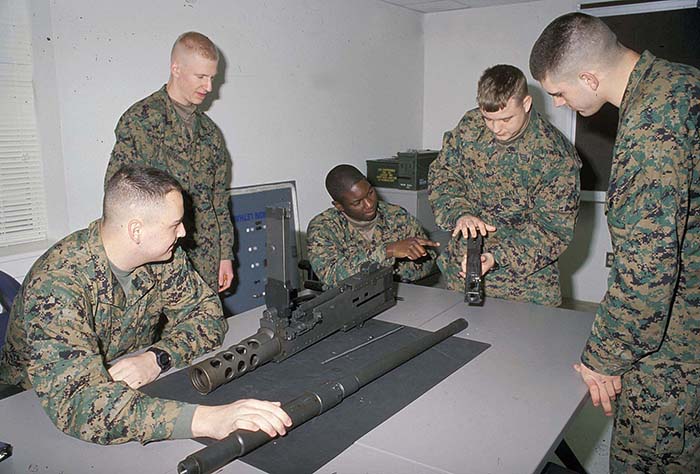
All this is particularly appreciated – and arguably necessary – with the MK19 as it has a two stage charging sequence that must be strictly attended to. Careless gunners who only charge it once (pull back the charging handles) will “no fire.” Worse, the doubly careless gunner who forgets he has already charged it twice will inadvertently fire the weapon while attempting a third cycle. Oops, sorry ‘bout that!
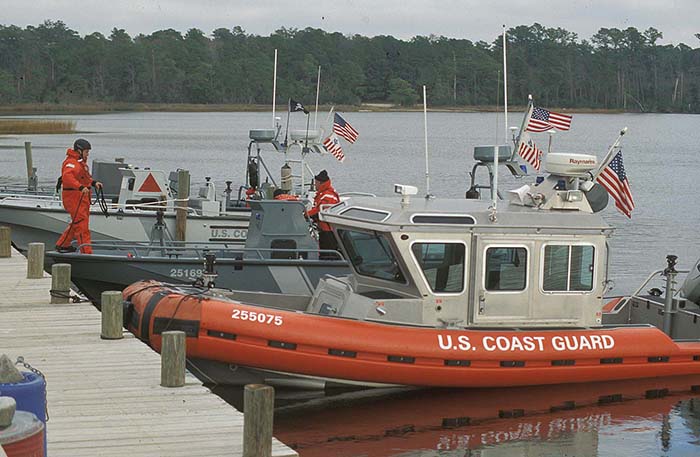
Phase two was fired with real M430 HEDP (high explosive dual purpose), a particularly effective combination warhead that will go through two inches of armor plate and also spray fragments in a five meter kill zone. The pucker factor is that it is known for occasionally detonating in the gun or – much worse – just a few meters from the muzzle. As such, Kevlar helmets and body armor plus thick ballistic goggles are always worn by all participants in live fire regardless of the type of ammunition.
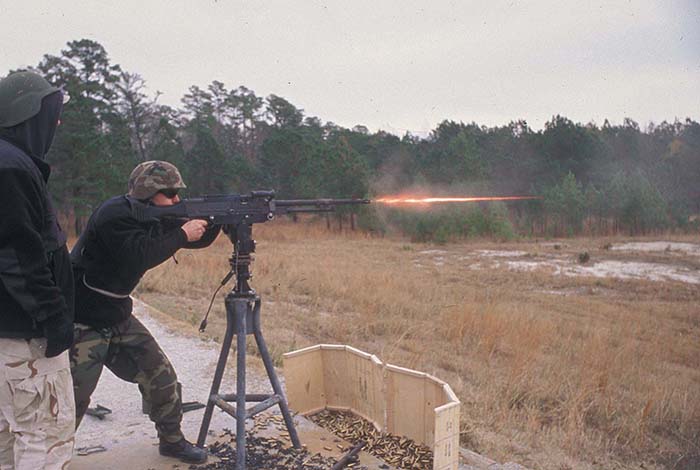
(Robert Bruce Military Photo Features)
Landlubber shooters have much to learn about small boat gunnery techniques. Instructors teach the students to firmly grasp the Mark 19’s spade grips and push the chest right into their fists. This, they explained, helps the gunner keep control of a free swinging weapon when the boat is underway in rough water.
The downside is this requires one hell of a lot of upper body strength and bicep endurance to do it for any period of time while actually underway. Plenty of pushups and pull-ups are in order as well as strengthening of the upper leg muscles that must constantly flex to cushion the gunner on a bouncing deck. There is no room for marginal physical fitness at these gun stations.
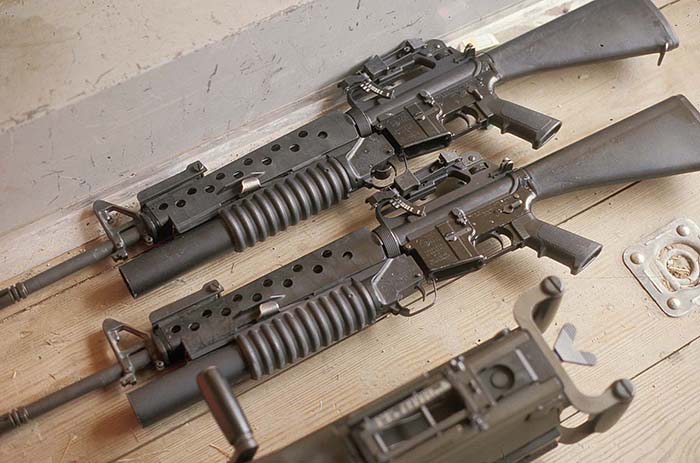
Reinforcement Training
With more shooters on site than guns, those waiting their turn were not idle. Instructors had them rotating through hands-on stations at wooden tables in front of the covered bleachers where each would once again go through stripping and assembly, loading, misfire procedures, and clearing. Sure, some grumbled that this was boring and repetitious, but that’s exactly what’s needed. Savvy instructors know that muscle memory and instinctive action are essential requirements for effective action under the stress of actual combat.
240 Time
After all students had the opportunity to live fire both practice and HE loads in the Mark 19, it was time to break out the 7.62mm M240s. Until recently, the Navy and Coast Guard have used veteran M60 machine guns in land, sea and air roles. But these Vietnam-era warhorses have seen better days and few tears are shed while they are being replaced as quickly as new shipments of M240 guns arrive, fresh off the production lines at FNMI in Columbia, South Carolina. This Belgian designed weapon has a well deserved reputation for being tough and reliable under the worst operational abuse and environmental extremes like salt spray, arctic cold and sandstorms.
The 24 pound M240N guns were secured atop the Mark 16 stand assembly in standard Mark 97 Mod 0 mounts, a single gun cradle with attached ammo cage for the usual 200 round steel boxes. A bigger one with 600 round capacity is also available as well as a Mark 99 Mod 0 twin gun mount. Stops on the Mark 16 Mod 8 Stand’s train (traversing) collar can be variously positioned to limit left-right swing as required for safety and a swing-up train lock adapter (travel lock) immobilizes everything when action is not imminent.
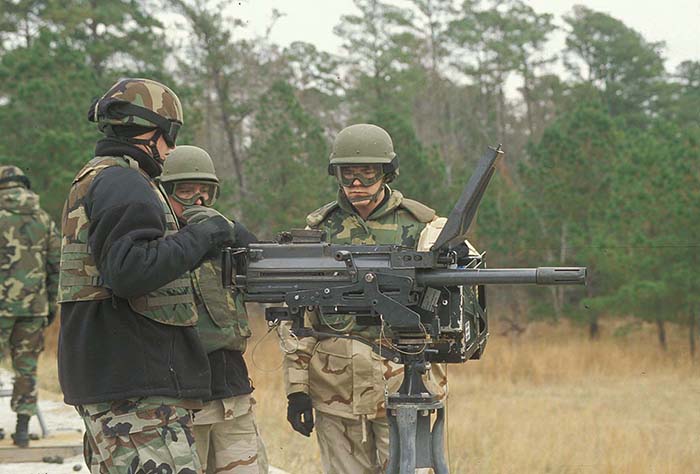
Countering the temptation to use the M240’s iron sights, gunners were encouraged to observe the tracer stream and impact signature to quickly bring the beaten zone onto designated targets. This would be a necessity when the training shifted to boats underway. Controlled bursts up to ten rounds conserved ammo while putting sufficient amounts of lead into the target for effective neutralization.
No Spin Zone
Our time on K211 was further enhanced by the opportunity to talk at length with Chief Hager, who spoke candidly on a number of subjects relevant to maritime gunnery that readers are invited to take note of:
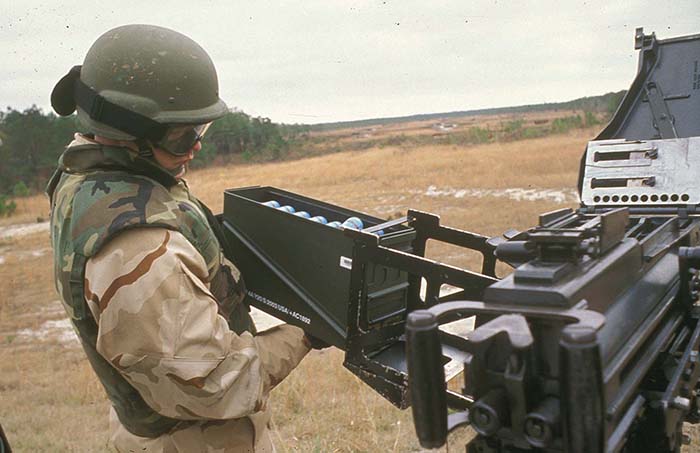
- “On their first day in class, students see real-world video of a fast and furious attack by well trained terrorists in heavily armed small boats.” This dramatic and sobering eye-opener drives home the seriousness of the protective mission that gunners have.
- Numerous combat after-action reviews have influenced the course content. One result is that “more emphasis is now being placed on security zones and interlocking fields of fire.”
- The M240 is very reliable under most conditions but proper lubrication varies with environmental conditions. “A 50/50 mixture of CLP and diesel fuel has been giving good results” in SW Asia.
- Ammunition availability for gunnery training needs to increase – particularly in .50 caliber. Hager acknowledges that electronic simulators like FATS (Fire Arms Training Systems) can help take up the slack, but he emphasized that “there is no substitute for actually shooting live rounds.”
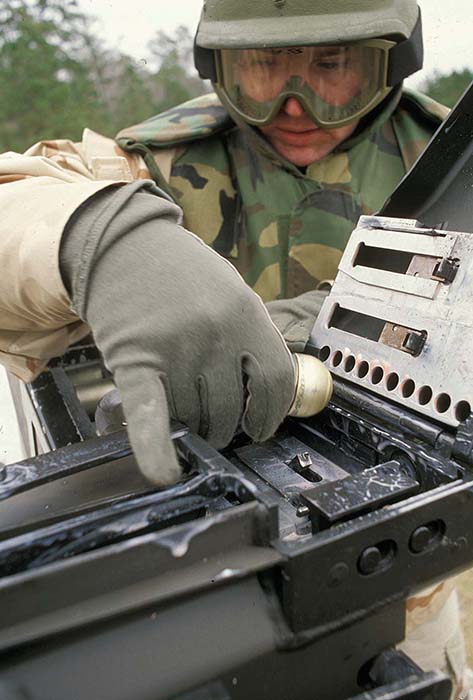
(Robert Bruce Military Photo Features)
(SMTC’s leadership advises that they have sufficient funding for training ammunition but the recent shortfall in available rounds is due to significantly increased demand by operational units in forward deployed areas. Barring unforeseen circumstances, this strain on the output of DoD’s relatively few production sources is likely to ease in the near future. Meanwhile, a customized FATS system is nearing completion that will allow sophisticated maritime scenario training with all three crew served weapons – Editor)
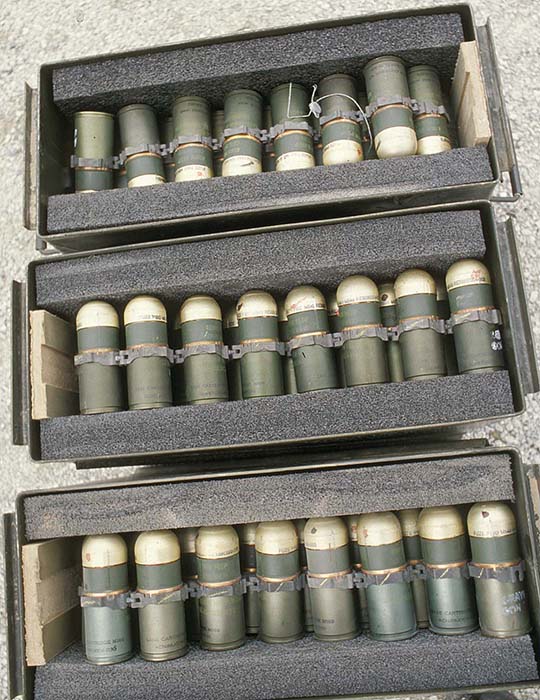
We also talked a bit with one of Hager’s students, MA3 (Master At Arms Third Class) Tony Pittaluga, a 26 year old native of Cape May, New Jersey with two years in the Navy. Currently assigned as a coxswain with Navy Mobile Security Detachment 22 in Portsmouth, Virginia, he and his unit are recent returnees from a deployment to Iraq securing vital oil terminals against terrorist attack. Pittaluga makes some interesting points to ponder:
- “Smooth is fast – fast is smooth.” Don’t try to rush through mechanical tasks like loading, clearing jams or assembly/reassembly. Practice repeatedly and speed will come naturally.
- Physical stress adds a lot of realism to gunnery training that is needed to prepare for effectiveness under fire. “Run and do exercises before handling the guns so your heart rate is up, hands trembling and sweaty.”
- Training ammunition shortages affect his home unit and it is a disappointment that the amount of ammo this class at SMTC will get is a lot less than what shipmates reported firing in earlier classes.
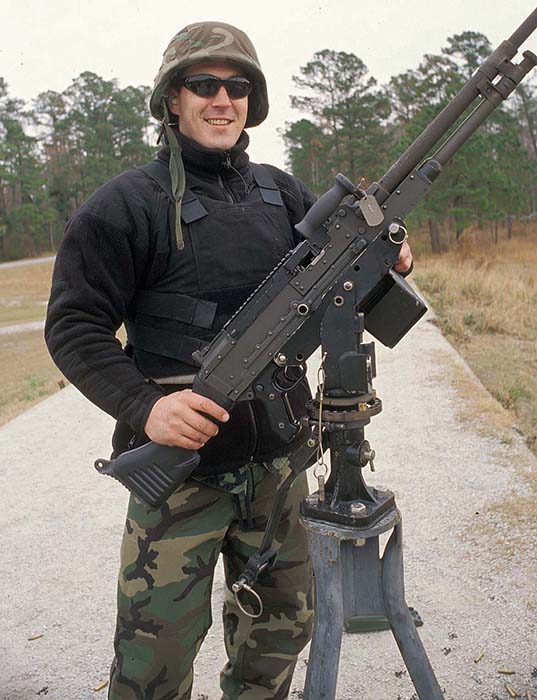
Night Fire and More
The students and staffers were in for another long day with scheduled firing after sundown under parachute flare illumination popped from M203 grenade launchers. A special treat was to be the chance to spend some quality time with a starlight scope. Night vision devices are hard to come by due to urgent operational requirements so the instructors were pleased to be able to borrow a brand new Litton AN/PVS-5 Crew Served Weapons Night Vision Sight for this group of students.
In a few days, the class would move out by small boat onto designated waterway ranges nearby for gunnery training while underway. Again, under the principle of “crawl, walk, run,” this would carefully progress from shooting off a static boat, to dry runs at slow speeds, then live fire runs at 5 knots and 10. Safety precautions are strictly enforced and the whole exercise is made exponentially difficult by environmental factors like sea condition, speed and direction of boat, target and wind, as well as the usual winter weather miseries of freezing rain and fog.
SMTC Expansion
A multi-million dollar construction program is well underway at the center’s Courthouse Bay location with six components nearing completion. This new Joint Maritime Complex includes a headquarters, academic instruction facility, armory, maintenance building, warehouse, and training pool. Also, a ship-on-shore shoot house, that will facilitate live fire scenarios unique to those required in boarding and securing oceangoing vessels, is pending congressional approval and funding.
This physical expansion will also support a growing list of missions arising from GWOT operations such as more boat and weapons training.
Coast Guard on the Web
The official website for SMTC is www.uscg.mil/smtc. Go to the US Coast Guard’s home page at www.uscg.mil to access information on opportunities, benefits and qualifications for enlistment. Good men and women are needed for Port Security Units, Maritime Safety and Security Teams, Cutter Boats, Helicopter Interdiction, and much more.
| This article first appeared in Small Arms Review V9N12 (September 2006) |











